World
About Andrew Cusack
 Writer, web designer, etc.; born in New York; educated in Argentina, Scotland, and South Africa; now based in London.
Writer, web designer, etc.; born in New York; educated in Argentina, Scotland, and South Africa; now based in London. read more
News
Blogs
Reviews & Periodicals
Arts & Design
World
France
Mitteleuropa
Knickerbockers
Argentina
The Levant
Africa
Cape of Good Hope
Netherlands
Scandinavia
Québec
India
Muscovy
Germany
Academica
Googlebosch
Google Street View Comes to the Eikestad and all South Africa
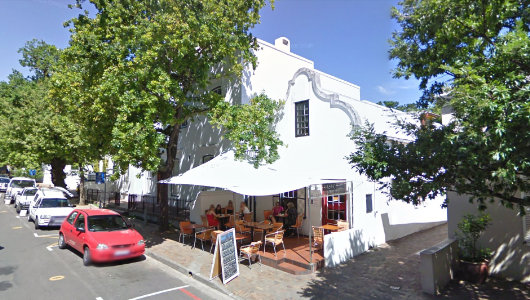
There had been rumours for a while. Talk had spread around the land of strangely equipped vehicles criss-crossing the country, and now the whole world can access Google Street View for South Africa. Naturally, they haven’t managed to capture every street in the whole country, but Cape Town, the Peninsula, and the Boland are well-covered, which naturally includes the handsome town of Stellenbosch that I used to call home. This of course provoked a mini-tour of the Eikestad and environs to see all the old familiar places. Above is Basic Bistro, the finest establishment in town, where one would oft find me planted outside with a pot of rooibos and the day’s edition of the Cape Times or Die Burger. The little alleyway to the right led to the back entrance to my old place. (more…)
Our Cardinal Strikes Again
Cardinal O’Brien, Scottish Primate, Preaches at Newly Ordained Priest’s First Mass in the Extraordinary Form at St. Mary’s Cathedral Edinburgh
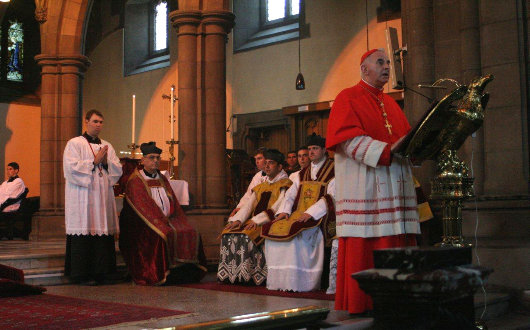
Keith Patrick O’Brien, the Primate of Scotland and Cardinal Archbishop of St Andrews & Edinburgh, this weekend preached at the first mass offered by the recently ordained Fr. Simon Harkins of the Priestly Fraternity of St. Peter. The mass was offered in the Cardinal’s own Cathedral of St. Mary in Edinburgh, Fr. Harkins’s own home town. The Very Rev. Fr Josef Bisig FSSP and the Very Rev. Fr. Franz-Karl Banauch FSSP assisted, and monks from the Transalpine Redemptorists of Papa Stronsay (who provided these photos) were also present, in addition to a number of diocesan priests.
I’ve spent the past eight years of my life divided between three (arch-) dioceses and I have to admit that Cardinal O’Brien is still the one I feel the greatest affection for. He’s an affable, uncomplicated fellow, and can be relied upon to defend what’s right in the media — unquestionably one of the best prelates in Britain today.
“I find him a much more approachable figure than other Scots prelates,” writes Damian Thompson, “less inclined to stand on his dignity despite (or perhaps because of) his red hat. I met him once at a party to relaunch the Scottish Catholic Observer, to whom he’s been a good friend; he didn’t sweep in surrounded by flunkeys, but hung around chatting in ordinary priest’s dress, reminding me a bit of Basil Hume in that respect.”
As it happens, I’m head of Cardinal O’Brien’s fan club on Facebook, which I encourage any Facebook users out there to join.
God bless our cardinal, and many congratulations to Fr. Hawkins! (more…)
Boom-studeer
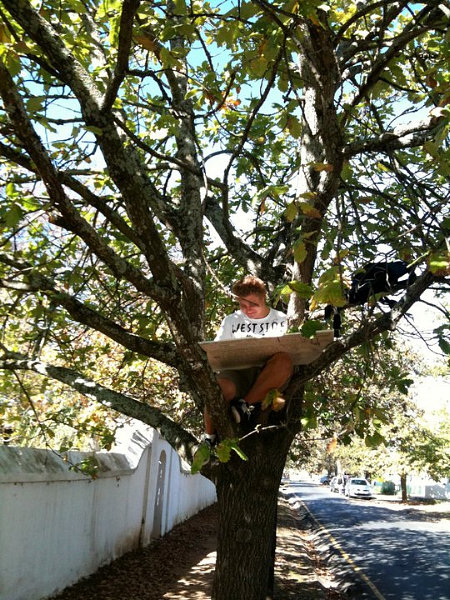
At Stellenbosch, when the J.S. Gericke Biblioteek is full-up, students must use their ingenuity to find other suitable locations where they can study for their exams.
The Versatility of the Cape Dutch Style
ORANJEZICHT IS ONE of my favourite parts of Cape Town, nestled in the bowl between Table Mountain and Signal Hill. Its name betrays it’s sloping location, which offers a view towards the Oranje bastion, one of the five of the Castle, which take their name from the titles of William, the Stadthouder of the United Provinces. The architecture is generally handsome, even if it often tends towards the Victorian. A few years ago, Cape Town Daily Photo featured a view (above) of the corner of Montrose Avenue and Bo-Oranjestraat in Oranjezicht. The late-autumn/early-winter street scene focusses on the Oranjezicht Carlucci’s, one of a small chain of delicatessens and wine shops founded in the mid-1990s.
The architecture of the shop is by no means in the strictest confines of the Cape Dutch style but is instead a more modern design influenced by the local architectural tradition of the Cape. While the Cape tradition is better known for larger country houses and wine-growing estates or small cottages, it’s just as useful a guide in the urban context. Dating the age of the building just by this photo would be tricky, as the region has some fairly convincing recent structures built in the old style (the dovecot at Alphen, for example), but I’d wager it’s 1900s-1910s construction that underwent a substantial renovation in the 1990s. (more…)
The Presiding Officer’s Gown
While the 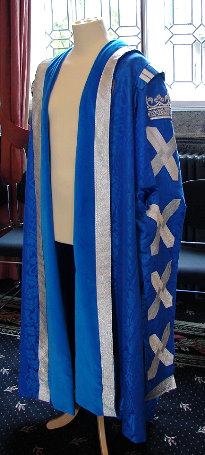 Westminster Parliament has a Speaker, the Scottish Parliament in Edinburgh has a “Presiding Officer” — a rather dull title if you ask me. The auld Estaits of Parliament abolished in 1707 were headed by the Lord Chancellor of Scotland, an office which fell into abeyance shortly after the Act of Union.
Westminster Parliament has a Speaker, the Scottish Parliament in Edinburgh has a “Presiding Officer” — a rather dull title if you ask me. The auld Estaits of Parliament abolished in 1707 were headed by the Lord Chancellor of Scotland, an office which fell into abeyance shortly after the Act of Union.
When the “Scottish Parliament” was refounded in 1997, the first man to hold the new job of Presiding Officer was Sir David Steel (the Rt. Hon. the Lord Steel of Aikwood), the despicable creature who as an MP introduced legal abortion to the United Kingdom in 1967, and who has inexplicably and disgracefully been created a Knight of the Most Ancient and Most Noble Order of the Thistle, the highest honour in the land (the Scottish equivalent of England’s Garter).
Anyhow, the St Andrews Fund for Scots Heraldry decided to commemorate the hosting of the Heraldic & Genealogical Congress in Scotland by commissioning a ceremonial gown for the Presiding Officer of the Scottish Parliament, who lacked one at the time. This rather handsome creation was presented to George Reid, the holder of the office at that time, during 27th International Congress of Genealogical and Heraldic Sciences held at St Andrews in 2006. Unfortunately I can find no evidence that this well-executed gown has ever been used. (more…)
The new Times of London online

IAM MILDLY obsessed with newspaper design (in case you hadn’t noticed that already). But even those few newspapers that manage to either be attractive or worth reading (or indeed both) usually have websites that are astoundingly ugly. Check out the websites of The Scotsman, Le Monde, or the Times of India. They vary from awful to “meh”. The website of The Hindu is ugly, but is being replaced by a much more handsome design. Despite the over-sized ad on the index page, Die Zeit‘s website is on the handsome side of things, but that of the Neue Zürcher Zeitung is a mixed bag, some well-done details here, other poor ones there. I despise lefigaro.fr, especially since they started charging for their e-paper edition. The structure and flow of telegraph.co.uk is actually good, but the detailing isn’t and (like faz.net) it poorly reflects its newspaper’s personality.
Along then strolls the once-venerable Times (f. 1785), with a brand spanking new website at thetimes.co.uk. Clear, orderly, precise in its details, and just plain handsome in its overall design. There’s nothing particularly special or over-the-top about it; it’s just well done, but that is shockingly rare for newspapers today. (more…)
It helps to be a 92-year-old D-Day veteran
Daniel Hannan, the whiggish MEP representing South East England, relays a story about His Excellency Philip Hannan, the 92-year-old former Archbishop of New Orleans:
When Hurricane Katrina wrecked the city, the old prelate went to the diocesan office to help. He found his successor wracked with concern about the fate of a parish priest who was lost in the storm. Seeing that anxiety had left the poor man paralysed, my 92-year-old kinsman called the military authorities.
“This is Phil Hannan. I jumped with the 82nd Airborne at Normandy. I need a helicopter”.
A helicopter duly arrived, and carried the former army padre to the home of the missing cleric, which had been turned to matchwood. Returning to the archiepiscopal residence, Hannan announced without ceremony, “He’s dead, may he rest in peace. Let’s move on to the next problem”.
St Andrews, William & Mary join forces
The oldest universities in Scotland and Virginia announce they will offer a series of joint degree programs
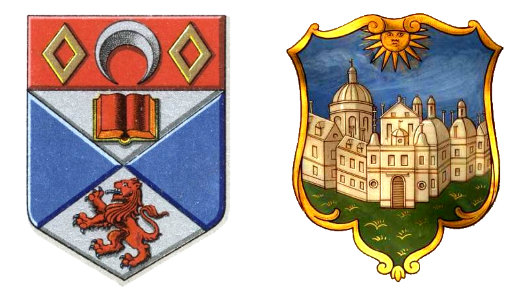
The University of St Andrews in Scotland and the College of William & Mary in Virginia are to begin offering joint degree programs starting in the autumn of 2011. Students admitted to the programs will receive a single Bachelor of Arts degree issued on behalf of both institutions — which will be the only B.A. offered by St Andrews, whose arts & humanities undergraduates typically graduate with an M.A.
The joint degrees will be available in four fields — history, international relations, English, and economics — with the aim of combining the depth traditional to the Scottish style of education with the breadth of William & Mary’s liberal curriculum. Students will spend the first year at their home university, followed by a second year abroad, with the remaining two years divided between the two. The program will start with about forty students divided between the two, with the hope to gradually double that size.
St Andrews is the oldest university in Scotland, and third-oldest in the English-speaking world. The College of William & Mary (now a university, despite its name) is the oldest in Virginia, the second-oldest in the United States, the third-oldest in North America, and the ninth-oldest in the English-speaking world. William & Mary, which is located in Virginia’s ancient capital of Williamsburg, has traditionally maintained links to Great Britain even after the Dominion of Virginia was recognised as independent in 1783. Queen Elizabeth II has visited the College twice, first in 1957 and more recently in 2007, and her former prime minister, Baroness Thatcher, served as Chancellor of the University.
Frederik van Zyl Slabbert, 1940–2010
FREDERIK VAN ZYL SLABBERT, former South African parliamentarian, politician, and briefly chancellor of Stellenbosch university, died last week in Cape Town. ‘Van’, as he was known, was convinced after a night of heavy drinking to stand as a parliamentary candidate for the Progressive Party in 1974 and won a surprise victory in the Rondebosch constituency against the United Party incumbent by 1,600 votes. Within three years he became head of the merged Progressive Federal Party, and became Leader of the Opposition in the House of Assembly in 1979.
Koos van der Merwe, currently Chief Whip of the Inkatha Freedom Party, served in parliament alongside the liberal van Zyl Slabbert while the former was still a member of the Conservative Party. “He was a parliamentarian par excellence,” van der Merwe said after Van’s death, “and I remember how once, in a mere three-minute speech, he practically annihilated P. W. Botha.”
Despite wide acclaim as one of the finest debaters in parliament, van Zyl Slabbert shocked the political establishment in 1986 by resigning because he was convinced that parliament had become irrelevant to the running of the country. His resignation nearly ruined the PFP and frayed van Zyl Slabbert’s relationship with his fellow MP, the late Dame Helen Suzman.
Just a year later he organised the first meetings between members of the banned African National Congress and a group of National Party politicians, Afrikaner academics, and businessmen. In later years he co-founded a black investment trust, was appointed chairman of the Johannesburg Stock Exchange, sat on the boards of a number of South African corporations, and worked for the Open Society Foundation. Van Zyl Slabbert was appointed Chancellor of the University of Stellenbosch — for whom he had played rugby as an undergraduate — in 2008 but resigned for health reasons a year later, and was succeeded by Johann Rupert.
Mr. van der Merwe continued:
What amazed me about Van Zyl Slabbert was the depth of his political knowledge and his wisdom. He knew and understood the policies of each political party better than they did themselves. On one occasion, at a seminar in Williamsburg in the U.S.A., I represented the Conservative Party and was confronted with questions I could not answer. I asked to be excused for a few minutes and went to van Van Zyl Slabbert and asked him how I, as a Conservative MP, should answer. He immediately gave me the right answers because he fully understood the views and beliefs of the Conservatives. And for that matter, each and every political party. He was in fact a mobile political library.
When the late Dr Treurnicht’s daughter approached Van Zyl Slabbert for assistance to move to the U.S.A. to marry a black man, Van Zyl Slabbert did not use that information against Treurnicht. At that stage, it was unthinkable for a white Conservative to marry a black man. News of Treurnicht’s daughter marrying a black man would have led to the end of Treurnicht’s political career. Van Zyl Slabbert confidentially told me the story but it never made the headlines. What an honourable man!
His part in the struggle for Afrikaans at Stellenbosch was indeed an eye opener. Where were the Verkramptes? The old Conservatives of which I was a member? Nowhere. The fight for Afrikaans was led by the “liberal jingoes” such as Van Zyl Slabbert, Hermann Giliomee, and Breyten Breytenbach. …
I also never once saw him angry.
Mooi loop, Van Zyl. Koos gaan jou mis.
Requiescat in pace.
In a Stellenbosch Garden
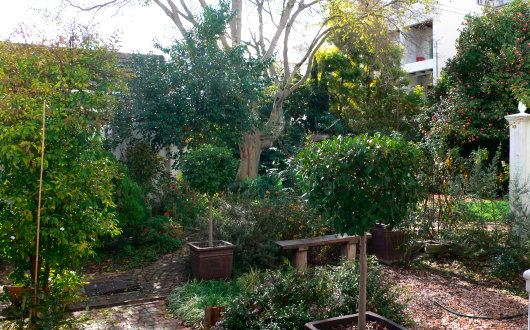
One of the pleasures of South Africa is that it is so conducive to the leafy things in life. Plants grow most of the year, so even while many of the trees may be bare, there is usually enough greenery about to keep things merry, as supported by the evidence of these shots of the garden of the little place in Stellenbosch where I used to live. Of course, this amenity to growth has its faults as well. Oak trees grow too quickly in this part of the world, leaving their wood too loose and unsuitable for use in barrelling. Wine- and brandy-makers must import their barrels from abroad, adding an irritating expense. Regardless of this incidental deficiency, South Africa still manages to produce some top-notch wines. (more…)
Swellendam Church Tower
In this video, the goodly folk of Swellendam demonstrate for us how not to remove a rotted wooden church tower. The little kid is a hoot — “It will get vrot and it will fall off on someone’s head”. The church tower has since been restored to its original iconic profile.
London Bridge City: The Neo-Venetian Scorned
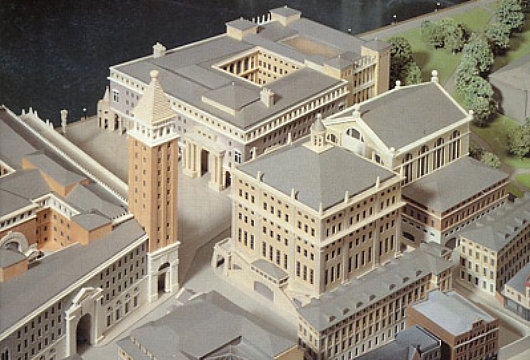
JOHN SIMPSON AND Partners 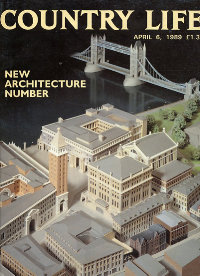 are one of the most prominent firms promoting classical architecture and urban design in Great Britain. They are perhaps most widely known for the work they did on the Queen’s Gallery at Buckingham Palace, as well as for the rejected scheme to redevelop Paternoster Square next to St. Paul’s Cathedral. Contemporary to their ultimately unsuccessful Paternoster Square bid was another ambitious scheme, Phase Two of the London Bridge City development. For Phase Two, Simpson composed a miniature Venice-on-the-Thames complete with Piazza San Marco and ersatz campanile. There seems, however, to be something just a bit un-English about the whole project. There are numerous examples of Ruskinian Venetian buildings throughout Britain, and indeed the Commonwealth, but an entire complex of Anglo-Neo-Venetian seems a bit over-the-top. Still, one can’t deny preferring a touch of Simpson’s over-the-top Venetian to the glass-plated boredom developers usually offer the public.
are one of the most prominent firms promoting classical architecture and urban design in Great Britain. They are perhaps most widely known for the work they did on the Queen’s Gallery at Buckingham Palace, as well as for the rejected scheme to redevelop Paternoster Square next to St. Paul’s Cathedral. Contemporary to their ultimately unsuccessful Paternoster Square bid was another ambitious scheme, Phase Two of the London Bridge City development. For Phase Two, Simpson composed a miniature Venice-on-the-Thames complete with Piazza San Marco and ersatz campanile. There seems, however, to be something just a bit un-English about the whole project. There are numerous examples of Ruskinian Venetian buildings throughout Britain, and indeed the Commonwealth, but an entire complex of Anglo-Neo-Venetian seems a bit over-the-top. Still, one can’t deny preferring a touch of Simpson’s over-the-top Venetian to the glass-plated boredom developers usually offer the public.
London Bridge City, Phase Two was proposed in the aftermath of the hugely popular speech by Prince Charles in which he condemned a planned modernist addition to the National Gallery as a “monstrous carbuncle on the face of a much-loved and elegant friend”. A bit of a donnybrook erupted between the architectural elite on the one hand (supporting the carbuncle) and the public on the other (supporting the Prince of Wales) and many a property developer was caught in the rhetorical crossfire. LBC’s backers decided, as an act of pragmatism, to come up with three radically different schemes in different styles and present them for consideration. (more…)
Titles in Afrikaans
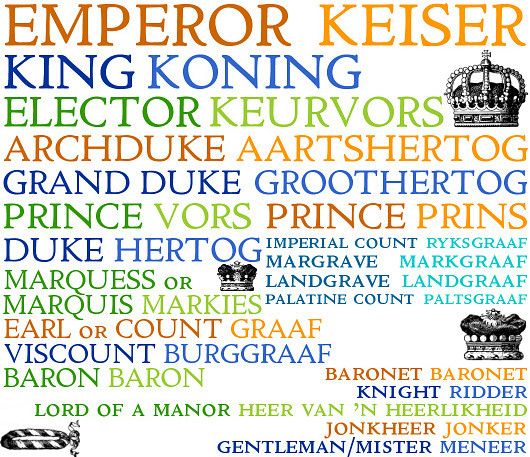
ROYAL, NOBLE, AND common titles in Afrikaans are, like most of the language, descended from Dutch antecedents which, in turn, come from German. The Cape knew not the Kingdom of the Netherlands, which was established after the Dutch relinquished the colony, but was founded as an outlet of the Dutch East India Company (or V.O.C., to give its Dutch acronym). After a brief period of British occupation, Dutch dominion over the Cape returned during the Batavian Republic before finally being seized by the British in 1806 and erected as a British colony in 1814. When the Union of South Africa was created in 1910, the country had its first king, George V, though the sovereign was generally only referred to as ‘King of South Africa’ from 1927 onwards.
The country has had no emperors, though some like to attribute that title to Shaka, the greatest King of the Zulus. Typically, however, he is known as king (as in King Shaka International Airport, Durban’s brand new landing-place). South Africa’s royalty have tended to be either native (like Prince Nelson Rolihlahla Mandela) or German (like Prince Hubertus of Prussia, d. 1950, and a few Blüchers, etc.). (more…)
Victory+65 in Moscow
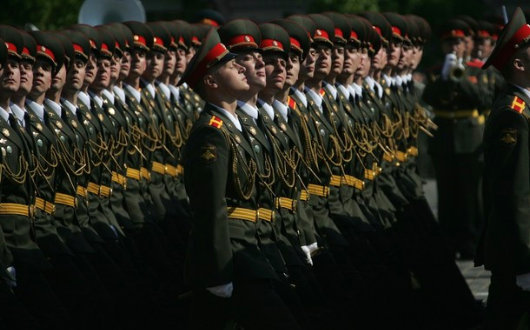
ANOTHER VICTORY DAY in Moscow — sixty-five years now since the Allied Powers defeated the crisply attired Axis of Nazi Germany and her slightly foppish cohort Fascist Italy. Russia commemorates V-E Day a day “late” because the German instrument of surrender entered into force at 23:01 CET on May 8, 1945 — by which time it was already May 9 in Moscow. For this reason most countries within the ex-Soviet sphere celebrate the end of the Second World War a day later than in western Europe. It is also customary on this day for patriotic citizens to wear the orange-and-black ‘Ribbon of St. George’, which recalls the Military Order of the Holy Great-Martyr and the Triumphant George established in 1769 and revived in 1994. The Order of St. George is the highest military honour awarded by Russia after the paramount Order of St. Andrew. (more…)
Cape Town’s Other St. George’s
The Greek Orthodox Cathedral of Saint George
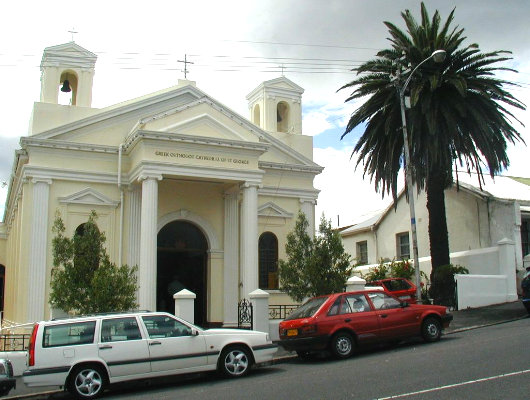
If you hear of “St. George’s Cathedral” in Cape Town, you naturally think of the big stone colossus at the bottom end of the Company’s Garden smack dab in the middle of the Mother City. There is, however, another St. George’s Cathedral, the Greek Orthodox Cathedral of St. George on Mountain Road in Woodstock. The Greek Cathedral was built in 1903–04, just a few years after Cape Town received its first Greek Orthodox priest, and expanded in 1983. Liturgies tend to be either in Greek or English, though there is an Afrikaans monastery at Robertson.
The Holy Archdiocese of the Cape of Good Hope was established in 1968 under the (Greek Orthodox) Patriarch of Alexandria and All Africa. The archdiocese covers the Western, Northern, and Eastern Cape provinces, the Orange Free State, KwaZulu-Natal, Namibia, Lesotho, and Swaziland.
I only ever knew one South African of Greek extraction (Dimitri! Not just a good egg, but a top-notch chef as well), but I assume that folks of Hellenic extraction enjoy the Mediterranean climate of Cape Town and its environs.
Cape Town’s New Way to Get Around

Over at Fascination Street, Brent Smith shows us the newly revealed branding for Cape Town’s new integrated rapid transit system: MyCiti. I’m not partlicularly impressed. Most of my fellow uitlanders will be forgiven for lacking an understanding of the stylised freehand letter ‘y’, which is rather tortured into representing an outline of Devil’s Peak, Tafelberg, and Lion’s Head. Mr. Smith diplomatically reserves judgement but I think they could’ve done better, although they could have done much worse.
Dr. Cornelis Pama
Die grootste Suid-Afrikaanse heraldikus
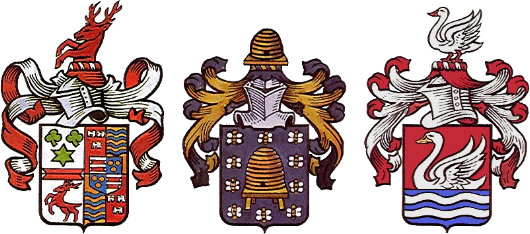
Ferreira — Bezuidenhout — Swanepoel
THE GRANDPAPA OF South African heraldry studies is undoutedly Dr. Cornelis Pama, a heraldist, genealogist, author, and editor of great importance in the field. Pama was one of the original members of the State Heraldry Council when it was founded in 1963 and refined the genealogical numbering system invented by Christoffel Coetzee de Villiers in the nineteenth century and which is now known as the de Villiers/Pama system in recognition of his contribution.
When I resume acquisitioning for my personal library, a whole slew of Pama’s works are on the ‘works sought’ list. Foremost among them is the excellent Lions and virgins: Heraldic state symbols, coats-of-arms, flags, seals and other symbols of authority in South Africa, 1487-1962 which I frequently made use of in the Stellenbosch university library.
Pama also wrote Heraldiek ABC (1980), Heraldiek in Suid-Afrika (1956), Simbole van die Unie (1960), British Families in South Africa: Their Surnames and Origins (1992), The Wine Estates of South Africa (1979), Vintage Cape Town: Historic Houses and Families In and Around the Old Cape (1973), and a history of the South African Library (the Cape Town institution which has since been foolishly merged with the Staatsbiblioteek in Pretoria to form the National Library of South Africa). The S.A.L. received his important private collection of over 800 genealogical and heraldic books and other works after Dr. Pama’s death in 1994. (more…)
A New Scots Town in the Highlands
The 20th Earl of Moray teams up with Miami-based firm Duany Plater-Zyberk to plant a New Town of 10,000 inhabitants outside Inverness
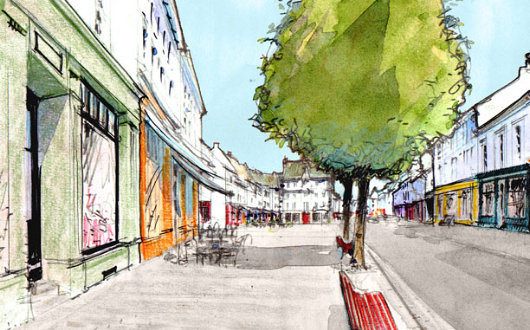
BELEIVE IT OR not, Inverness is one of the fastest-growing cities in Europe, and a local landowner, the 20th Earl of Moray, has teamed up with Duany Plater-Zyberk, an American firm known for its traditional architecture and urbanist ideas, to help create a sustainable new town of 10,000 inhabitants near the “Capital of the Highlands”. Tornagrain will rest on a 200-hectare (500-acre) site on the A96 corridor between Inverness and Nairn. Much of the recent growth in the Highlands has been poorly managed, raising concerns of suburban sprawl and poor land management. Moray Estates, the land holding company of the Earl of Moray (pronounced ‘Murry’) has decided to take the lead by planning a new town in the best tradition of Scottish architecture and urban development. (more…)
The Old New York Observer Building
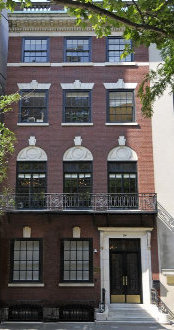
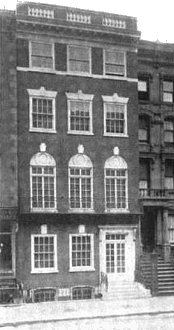
No. 54, East Sixty-fourth Street
“FOR 17 YEARS,” writes Peter W. Kaplan, “since The New York Observer entered city life in 1987, it has existed within a red brick and white-marble-stepped townhouse on East 64th Street.” Designed by Ernest Flagg and Walter B. Chambers during their brief partnership, No. 54 East Sixty-fourth Street (between Park & Madison) was built in 1907 as a private residence for Robert I. Jenks. The AIA guide accurately describes it as “four stories of delicate but unconvincing neo-Federal detail… a minor Flagg.” In 1947, the townhouse was converted into offices for the Near East Foundation, which was founded in 1915 to provide relief for Armenian refugees from the Ottoman Empire and later took on greater responsibilities in North Africa and the Levant. It was then bought by Arthur L. Carter, the founder and publisher of the New York Observer for use as the salmon-tinted newspaper’s headquarters.
In 2004, the Observer moved down to Broadway, two blocks south of the Flatiron Building (and just a few blocks up from The New Criterion whose founder, Hilton Kramer, was for nearly two decades the art critic for the Observer). The townhouse was sold by Carter to the Russian-born Janna Bullock, real estate developer & sometime Guggenheim foundation board member for $9.5 million in the year the newspaper moved out. In 2005, Bullock renovated the building and had it used at the Kips Bay Decorator Show House for the year before selling it on to the Irish investor Derek Quinlan for $18.74 million. Quinlan put it on the market for $36 million but last year the asking price was chopped to $27 million.
Twenty-five feet wide, five stories, and with over 10,000 square feet, No. 54 was probably the only newspaper headquarters to feature nine working fireplaces, rosewood panelling, and oak wainscoting. But the best feature, by a mile, is the splendid iron-railed staircase, which looks like it was lifted straight from Paris. Elegant and graceful, a rare century-old survival in Manhattan. (more…)
Cockerell’s Carlton Club
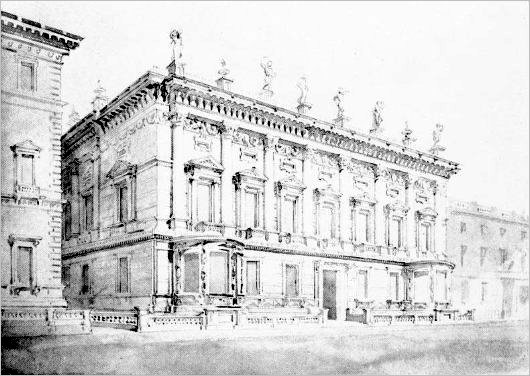
Charles Robert Cockerell is best known for designing both the Ashmolean Museum at Oxford and its Cambridge equivalent, the Fitzwilliam Museum. He is also, alongside William Henry Playfair, responsible for the twelve-columned National Monument that sits atop Calton Hill in Edinburgh — allegedly unfinished, though there is considerable debate over whether this is so. It’s not widely known, however, that the famous architect Cockerell completed a design for a new home for the Carlton Club on Pall Mall in London.
Originally Cockerell had declined the opportunity to submit a design, with such lofty names as Pugin, Wyatt, Barry, and Decimus Burton also declining the offer. A few years later, Cockerell nonetheless worked on this design for the Tory gentlemen’s club, which is superior to that conceived by another architect which was eventually built. Cockerell devised a “lofty Corinthian colonnade of seven bays” according to the Survey of London. “The columns have plain shafts, their capitals are linked by a background frieze of rich festoons, and the Baroque bracketed entablature is surmounted by an open balustrade with solid dies supporting urns and gesticulating statues.” (more…)
Search
Instagram: @andcusack
Click here for my Instagram photos.Most Recent Posts
- Amsterdam November 26, 2024
- Silver Jubilee November 21, 2024
- Articles of Note: 11 November 2024 November 11, 2024
- Why do you read? November 5, 2024
- India November 4, 2024
Most Recent Comments
- on The Catholic Apostolic Church, Edinburgh
- on Articles of Note: 11 November 2024
- on Articles of Note: 11 November 2024
- on Why do you read?
- on Why do you read?
- on University Nicknames in South Africa
- on The Situation at St Andrews
- on An Aldermanian Skyscraper
- on Equality
- on Rough Notes of Kinderhook
Book Wishlist
Monthly Archives
Categories


